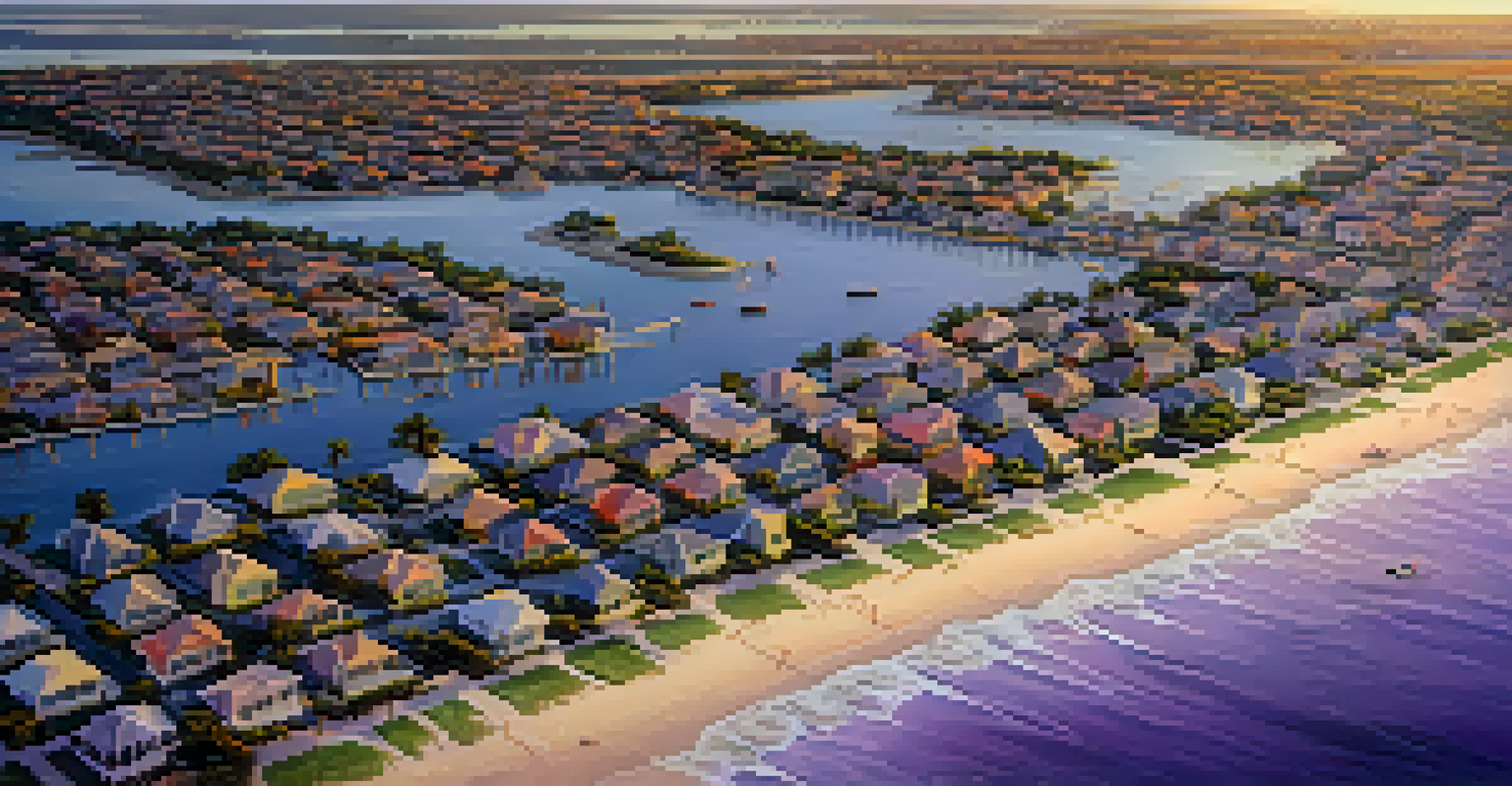The Role of Urbanization in Florida's Weather Variability

Understanding Urbanization in Florida's Context
Urbanization refers to the increasing population in urban areas, leading to the expansion of cities and towns. In Florida, this has meant rapid development, particularly in coastal areas and cities like Miami and Orlando. The transformation of land from natural habitats to urban environments significantly alters local ecosystems and climate patterns.
Cities are the future, and while they can lead to environmental challenges, they also have the potential to be the solution through innovative urban planning.
As more people flock to Florida for its warm climate and vibrant lifestyle, urban areas have grown to accommodate them. This growth often involves the construction of roads, buildings, and other infrastructure. However, these developments can disrupt natural processes, such as water drainage and air circulation, contributing to changes in local weather.
Understanding urbanization is essential for examining its broader effects on weather variability. The interplay between urban growth and weather patterns reveals critical insights into how human activities can modify natural phenomena, affecting everything from temperature to precipitation.
The Urban Heat Island Effect Explained
One of the most significant impacts of urbanization on weather is the Urban Heat Island (UHI) effect. This phenomenon occurs when urban areas experience higher temperatures than their rural surroundings due to human activities and infrastructure. In Florida, cities can become significantly warmer, particularly during the summer months.

The materials used in urban construction, such as concrete and asphalt, absorb and retain heat more than natural landscapes. This heat retention can lead to localized temperature increases, affecting weather patterns and even influencing storm formation. For instance, warmer urban areas can enhance convection, potentially leading to more intense rain showers.
Urbanization Drives Weather Changes
The rapid development in Florida's urban areas significantly alters local ecosystems and weather patterns, impacting everything from temperature to precipitation.
The UHI effect highlights the need for sustainable urban planning. Incorporating greenery, such as parks and green roofs, can help mitigate these temperature increases and promote a more balanced local climate.
Impact of Urbanization on Rainfall Patterns
Urbanization can significantly alter rainfall patterns, particularly through the process of rainfall intensification. As cities expand, the increased surface area of buildings and roads can lead to higher rates of runoff, which in turn may affect local precipitation dynamics. In Florida, this often results in heavier rainfall concentrated in urban areas.
Nature is not a place to visit. It is home. We are part of nature, and we must integrate it into our urban environments.
Moreover, urban areas can create their own weather systems. Heat generated by buildings and vehicles can uplift air, causing it to cool and condense more rapidly, leading to thunderstorms. This phenomenon is particularly evident in Florida, where summer storms can quickly develop in response to urban heat.
Understanding these changes in rainfall patterns is vital for urban planners and residents alike. By recognizing how urbanization influences precipitation, communities can better prepare for potential flooding and other weather-related challenges.
Sea Level Rise and Urban Vulnerability
Florida is particularly vulnerable to sea level rise, a consequence of climate change exacerbated by urbanization. As cities expand along the coast, they not only increase their population density but also their exposure to flooding and storm surges. This creates a complex relationship between urban growth and environmental risks.
Coastal cities like Miami face significant challenges as rising waters threaten infrastructure and ecosystems. Urbanization often leads to the destruction of natural barriers, such as wetlands, which play a crucial role in flood mitigation. This loss increases the vulnerability of urban areas to extreme weather events.
Urban Heat Island Effect Explained
Cities in Florida experience higher temperatures than surrounding rural areas, primarily due to human activities and infrastructure, highlighting the need for sustainable urban planning.
Addressing sea level rise requires innovative urban planning strategies that incorporate resilience and sustainability. By preserving natural landscapes and investing in protective infrastructure, Florida can better safeguard its urban areas against the impacts of climate change.
The Role of Green Spaces in Urban Florida
Incorporating green spaces within urban settings can play a critical role in mitigating the effects of urbanization on weather variability. Parks, green roofs, and urban forests not only enhance the aesthetic appeal of cities but also help regulate temperature and improve air quality. In Florida, these green areas are essential for combating the Urban Heat Island effect.
Moreover, green spaces can aid in managing stormwater runoff, reducing the risk of flooding during heavy rains. By allowing water to permeate the soil, these areas can decrease the amount of water that overwhelms drainage systems. This is especially important in Florida, where intense rainfall events are common.
Ultimately, fostering green spaces within urban Florida not only enhances livability but also contributes to a more stable and resilient weather environment. Communities that prioritize nature in their urban planning can experience significant benefits in terms of climate adaptation.
Human Behavior and Weather Perception
Urbanization influences not only the physical aspects of weather but also how people perceive and respond to it. With an increasing number of residents in urban areas, the collective behavior and attitudes towards weather events can shift. For instance, the frequency of extreme weather events may lead to heightened anxiety and a call for better preparedness.
In Florida, where tropical storms and hurricanes are a reality, urbanization heightens the stakes for residents. Awareness campaigns and community preparedness initiatives can help residents understand the risks associated with their urban environment. Engaging communities in these discussions can foster a culture of resilience.
Green Spaces Mitigate Urban Challenges
Incorporating green spaces in urban Florida not only enhances livability but also helps regulate temperature and manage stormwater runoff, contributing to climate resilience.
By understanding how human behavior intersects with weather variability, city planners and emergency managers can develop more effective strategies for communication and response. This holistic approach ensures that residents are informed and prepared for the challenges posed by urbanization and climate change.
Future Considerations for Urban Planning
As Florida continues to urbanize, future planning must prioritize sustainability and resilience in the face of changing weather patterns. This involves not only considering how urbanization impacts weather but also how to adapt urban infrastructure to withstand these changes. Effective strategies can include investing in sustainable transportation, energy-efficient buildings, and resilient drainage systems.
Urban planners should also consider the benefits of incorporating technology to monitor environmental changes. Utilizing data-driven approaches can help anticipate weather-related challenges and inform decision-making processes. With the right tools, cities can adapt more effectively to the evolving climate landscape.

Ultimately, the future of Florida's urban areas depends on proactive measures that recognize the intricate relationship between urbanization and weather variability. By embracing sustainable practices, Florida can create livable cities that thrive despite the challenges posed by climate change.